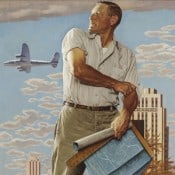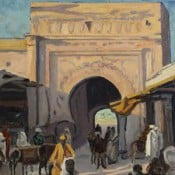Explore
![]()
Kehinde Wiley
(American, born 1977)
Santos Dumont – The Father of Aviation (from The World Stage: Brazil), 2009
oil on canvas, 72 x 60 inches
Artwork courtesy of the Artist and Roberts & Tilton, Culver City, California
Kehinde Wiley updates the tradition of portraiture, making it relevant to our time. Unlike portraits of past centuries, which rarely depict people of color, the main subject of his work is African American men. Wiley meets his models on the streets of Harlem and other urban centers, choosing men who exude a “spirit of self-possession,” and invites them re-enact poses depicted in historic works of art. By painting young black men in the guise of Old Master paintings, both sacred and secular, he places them in a position of power and authority historically denied to them, reclaiming art history for those who have been conspicuously absent from it.
In recent years Wiley has traveled globally to represent men of African descent in other countries for an ongoing project called “The World Stage.” This painting from his “The World Stage: Brazil” series depicts an Afro-Brazilian youth mimicking the pose of a bronze monument dedicated to a pioneer of aviation in Rio de Janeiro. Wiley’s modern restaging of the classical sculpture can be interpreted as a symbol of transcendence over adversity, of aspiration to greater heights.
Kehinde Wiley was chosen to paint a portrait of former president Barack Obama for the Smithsonian National Portrait Gallery in Washington. The portrait was unveiled in February of 2018, and depicts Mr. Obama seated in a lush garden of flowers and bright green foliage.
I’m attempting to engage a question, not necessarily around the history of portraiture or religious iconography and propaganda surrounding wealthy white men, or the class disparities between the rich and the poor in America, or the race disparity, but rather a type of celebration. . . the magic that can occur when all of these different possibilities interact in some way.
Other Works by Kehinde Wiley
No related posts found




